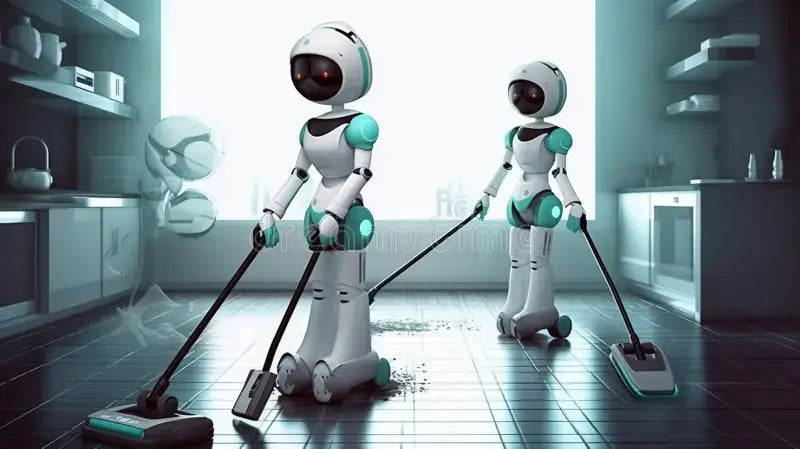Let's cut to the chase—cleaning sucks. It's repetitive, time-consuming, and the second you finish, someone spills something, tracks in mud, or decides to make "slime" in your kitchen. (Thanks, TikTok.) No wonder the robotic cleaner market is booming, with promises to liberate us from our mops and vacuums like some kind of domestic revolution.
But here's the million-dollar question: Do these expensive little robots actually deliver, or are they just shiny disappointments with good marketing? After testing dozens of robotic cleaners across every category and price point, I've got some strong opinions about which ones are worth your hard-earned cash and which ones belong in the junk drawer of broken dreams.
The Automated Cleaning Landscape: Beyond Just Vacuums
When most people think of robotic cleaners, they picture those disc-shaped vacuum robots bumping around the living room. But the market has exploded into specialized niches that tackle specific cleaning challenges:
- Floor cleaning robots: Vacuums, mops, and combo units
- Window cleaning robots: For interior and exterior glass surfaces
- Pool cleaning robots: For maintaining swimming pools
- Gutter cleaning robots: For removing leaves and debris
- Lawn mowing robots: For keeping your grass trimmed
- Bathroom-specific robots: Specialized for shower and toilet cleaning
Today, we'll focus on the three categories that deliver the most value for most homeowners: robotic vacuums, window cleaners, and pool cleaners. These are the areas where the technology has matured enough to be truly effective, not just novelties.
Robotic Vacuums: The Gateway Robot
What They Do Well:
- Maintain floors with minimal intervention
- Reduce visible dust and pet hair
- Work while you're away from home
- Reach under furniture that's awkward for humans
What They Don't:
- Deep-clean carpets like a full-sized vacuum
- Handle significant obstacles or clutter
- Clean stairs (obviously)
- Spot-clean spills effectively
When They're Worth It:
If you have primarily hard floors or low-pile carpeting, a robotic vacuum can legitimately reduce your cleaning time by 80%. They're especially valuable for:
- Pet owners: Nothing keeps up with shedding like a daily robot cleaning
- Open floor plans: More unobstructed space means more efficient cleaning
- Busy households: Where daily manual vacuuming isn't realistic
- Allergy sufferers: Regular removal of dust and allergens makes a noticeable difference
Key Features That Actually Matter:
Navigation Technology: This is the biggest differentiator between budget and premium models. Random navigation (bouncing around until the room is eventually covered) works okay for small spaces but becomes inefficient in larger homes. Look for:
- LIDAR/laser mapping: Creates precise home maps
- Camera-based navigation: Good but can struggle in low light
- Virtual boundaries: To keep robots away from problem areas
- Room-specific cleaning: For targeting just the kitchen after cooking
Suction Power: Measured in Pascals (Pa), with higher numbers indicating stronger suction. For context:
- 1,500-2,000 Pa: Handles hard floors and light dust
- 2,500-3,000 Pa: Good for low-pile carpet and pet hair
- 4,000+ Pa: Can handle medium-pile carpet and heavier debris
Battery Life & Self-Emptying: Longer runtime means more coverage, but what really matters is how the robot handles a low battery:
- Return and resume: Recharges then continues where it left off
- Self-emptying docks: Empty the robot's bin automatically (game-changer!)
App Quality & Updates: Often overlooked but crucial—a clunky app makes scheduling and control frustrating, while companies that regularly update their software keep improving your investment over time.
Best Value vs. Premium Pick:
Best Value: The sweet spot for price/performance is $300-500. In this range, you'll get reliable navigation, good suction, and essential smart features without paying for premium brand names.
Premium Pick: If you want the absolute best, expect to pay $800-1,200. The additional money gets you superior obstacle avoidance, more sophisticated mapping, quieter operation, and longer-lasting components.
Window Cleaning Robots: Worth It For Specific Scenarios
Window robots like the SmartPro UltraClean Robotic Window Cleaner are specialized tools that really shine in very specific circumstances. They're not for everyone, but for the right situation, they're almost magical.
What They Do Well:
- Clean exterior windows safely from inside
- Reach tall or inaccessible windows
- Provide streak-free cleaning with minimal effort
- Eliminate the need for ladders or professional services
What They Don't:
- Work well on textured or uneven glass
- Clean window frames or sills
- Move between separate windows independently
- Match a human's ability to spot-clean stubborn marks
When They're Worth It:
Window cleaning robots make the most sense for:
- Homes with high or difficult-to-reach windows: Two-story foyers, stairwell windows, skylights
- Properties with many large windows: When manual cleaning would take hours
- Safety concerns: Eliminating ladder use for older homeowners or those with mobility issues
- Regular maintenance: Keeping windows consistently clean rather than letting grime build up
Key Features That Actually Matter:
Safety Systems: This is non-negotiable for devices that hang from your windows. Look for:
- UPS (uninterrupted power supply): Battery backup if power fails
- Strong suction or magnetic systems: To maintain secure attachment
- Fall prevention technologies: Multiple safety algorithms and physical tethers
Cleaning Performance:
- Multi-stage cleaning: Spray, scrub, and squeegee functions
- Edge detection: Ability to recognize window frames
- Cleaning pattern: Systematic patterns are more efficient than random movement
Ease of Use:
- Remote control vs. app control: Both have advantages
- Setup time: Some models require complex preparation
- Weight: You'll need to place it on each window
The SmartPro UltraClean excels in most of these areas, particularly safety systems and edge detection, which is why it's become popular with homeowners who previously dreaded window cleaning day.
Pool Cleaning Robots: Summer's Secret Weapon
If you own a pool, you know the constant battle against leaves, dirt, algae, and mysterious gunk that appears overnight. Pool maintenance can easily eat up 2-3 hours per week during swimming season. That's where robotic pool cleaners like the Hydro-Puls Robotic Pool Cleaner come in.
What They Do Well:
- Clean pool floors, walls, and waterline
- Filter out fine particles and debris
- Reduce chemical usage by improving circulation
- Work independently of your pool's filtration system
What They Don't:
- Replace occasional manual cleaning entirely
- Clean specialized areas like stairs as effectively
- Remove large debris like branches after storms
- Self-clean (you'll need to rinse filters)
When They're Worth It:
Pool robots deliver exceptional value for:
- Regular pool users: The more you use your pool, the more you'll appreciate consistent cleanliness
- Yards with heavy foliage: Trees mean constant debris
- Busy pool owners: Who don't have hours for weekly maintenance
- Those wanting to reduce chemical use: Better cleaning means less need for chemicals
Key Features That Actually Matter:
Cleaning Coverage:
- Climbing ability: Can it clean walls and waterline or just the floor?
- Smart navigation: Systematic cleaning patterns vs. random movement
- Obstacle management: Ability to navigate around drains, ladders, etc.
Filtration Quality:
- Micron rating: Lower numbers mean finer filtration (look for 50 microns or less)
- Filter capacity: Larger capacity means less frequent emptying
- Top-loading vs. bottom-loading: Top-loading filters are cleaner to empty
Practical Considerations:
- Cycle time: How long it takes to clean an average pool (2-3 hours is standard)
- Cord management: Anti-tangle swivel is essential
- Energy efficiency: Operating costs can vary significantly
The Hydro-Puls model hits the sweet spot for most pool owners, with excellent wall climbing, effective filtration, and intuitive controls that don't require an engineering degree to operate.
The Dirty Truth: What No One Tells You About Robotic Cleaners
Before dropping hundreds (or thousands) on a robotic cleaning army, here are some hard truths the glossy marketing materials won't tell you:
The "Pre-Cleaning" Reality
Most robotic cleaners require you to "pre-clean" before they can do their job effectively. This means picking up clutter, moving certain obstacles, and generally preparing the area. This preparation time eats into the time savings, especially for vacuum robots in cluttered households.
Reality check: The messier your home typically is, the less benefit you'll get from robotic cleaners.
Maintenance Requirements
Robots need regular maintenance to perform well. This includes:
- Emptying bins/filters
- Cleaning brushes and wheels
- Removing tangled hair and debris
- Occasional part replacement
Reality check: Budget 5-10 minutes of maintenance per week for each robotic cleaner you own.
The Area-Specific Limitation
Most robotic cleaners are designed for specific areas or surfaces and can't move between them independently. Your pool robot can't climb out and start vacuuming your living room (thank goodness).
Reality check: Comprehensive robotic cleaning requires multiple specialized devices, not a single miracle machine.
The "Good Enough" Standard
Robotic cleaners typically do a "good enough" job, not a perfect one. They're excellent for maintenance cleaning but may miss spots that a human would catch.
Reality check: Occasional manual cleaning is still necessary, but much less frequently.
Making the Smart Investment: A Practical Approach
Instead of going all-in on robotic everything, consider this stepped approach:
Step 1: Start with a quality robotic vacuum.
This delivers the most immediate impact on day-to-day cleanliness. Use it for 2-3 months to understand how automation fits into your cleaning routine.
Step 2: Identify your next biggest cleaning pain point.
Is it windows? Pool maintenance? Lawn care? Target your second robotic purchase at whatever consumes the most time or causes the most frustration.
Step 3: Wait for sales and technological improvements.
The robotic cleaning market moves fast. New models with better features emerge regularly, and prices on slightly older models drop significantly during sales events.
Step 4: Consider your total cleaning ecosystem.
The best approach combines robotic maintenance with occasional human intervention for detailed cleaning. Find the balance that works for your household.
The Bottom Line: Are They Worth It?
After years of testing robotic cleaners, my verdict is a qualified yes—with caveats:
- Robotic vacuums: Worth it for 90% of households
- Pool robots: Worth it for nearly all pool owners
- Window robots: Worth it for specific scenarios (many windows, safety concerns)
- Other categories: Still maturing; wait for technology improvements unless you have specific needs
The key is matching the robot to your actual cleaning challenges and setting realistic expectations. These are maintenance tools, not miracle workers. They reduce cleaning time dramatically but don't eliminate it entirely.
Remember, the goal isn't a spotless, instagram-perfect home—it's reclaiming your time for things that matter more than pushing a vacuum around. And for that purpose, the right robotic cleaners deliver in spades.
What's your experience with robotic cleaners? Have they lived up to the hype in your home? Share your thoughts in the comments below!




Leave a comment
This site is protected by hCaptcha and the hCaptcha Privacy Policy and Terms of Service apply.